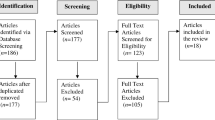Abstract
This study was a systematic extension of Karmali, Greer, Nuzzulo-Gomez, Ross, and Rivera-Valdes (2005) and Ahearn, Clark, MacDonald, and Chung (2007). We investigated the effects of a tact correction procedure on stereotypic vocalizations in 4 children diagnosed with autism who ranged in age from 6 to 16 years. Participants had limited vocal verbal repertoires and were primarily dependent on prompts for the emission of appropriate vocalizations. A multiple-baseline design across participants was used. Data were collected on instances of stereotypic vocalizations and independent tacts during baseline conditions and on instances of stereotypic vocalizations, independent tacts, and echoic-tacts during intervention. Procedural integrity and social validity data were also obtained. The results indicated a decrease in stereotypic vocalizations for 3 of the 4 participants and a slight increase in appropriate vocal verbal behavior (i.e., tacting) for all participants. The study provides support for the use of tact correction procedures to decrease stereotypic vocalizations and increase appropriate vocalizations in children with autism.
Similar content being viewed by others
References
Ahearn, W. H., Clark, K. M., MacDonald, R. F., & Chung, B. I. (2007). Assessing and treating stereotypic vocalizations in children with autism. Journal of Applied Behavior Analysis, 40, 263–275.
Baer, D. M., Wolf, M. M., & Risley, T. R. (1968). Some current dimensions of applied behavior analysis. Journal of Applied Behavior Analysis, 1, 91–97.
Bondy, A., Tincani, M., & Frost, L. (2004). Multiply controlled verbal operants: An analysis and extension to the picture exchange communication system. The Behavior Analyst, 27(2), 247–261.
Cunningham, A. B., & Schreibman, L. (2008). Stereotypy in autism: The importance of function. Research in Autism Spectrum Disorders, 2(3), 469–479.
Foxx, R. M., Faw, G. D., McMorrow, M. J., Kyle, M. S., & Bittle, R. G. (1988). Replacing maladaptive speech with verbal labeling responses: An analysis of generalized responding. Journal of Applied Behavior Analysis, 21, 411–417.
Karmali, I. L., Greer, R. D., Nuzzulo-Gomez, R., Ross, D. E., Rivera-Valdes, C. (2005). Reducing palilalia by presenting tact corrections to young children with autism. The Analysis of Verbal Behavior, 21, 145–153.
Karsten, A. M., & Carr, J. E. (2009). The effects of differential reinforcement of unprompted responding on the skill acquisition of children with autism. Journal of Applied Behavior Analysis, 42, 327–334.
Kennedy, C. H., Meyer, K. A., Knowles, T., & Shukla, S. (2000). Analyzing the multiple functions of stereo-typical behavior for students with autism: Implications for assessment and treatment. Journal of Applied Behavior Analysis, 33, 559–571.
Lerman, D. C., & Iwata, B. A. (1996). A methodology for distinguishing between extention and punishment effects associated with response blocking. Journal of Applied Behavior Analysis, 29, 231–233.
Liu-Gitz, L., & Banda, D. R. (2010). A replication of the RIRD strategy to decrease vocal stereotypy in a student with autism. Behavioral Interventions, 25(1), 77–87.
Mace, F. C., Browder, D. M., & Lin, Y. (1987). Analysis of demand conditions associated with stereotypy. Journal of Behavior Therapy and Experimental Psychiatry, 18, 25–31.
Miguel, C. F., Clark, K., Tereshko, L., & Ahearn, W. H. (2009). The effects of response interruption and redirection and sertraline on stereotypic vocalizations. Journal of Applied Behavior Analysis, 42(4), 883–888.
Pistoljevic, N., & Greer, R. D. (2006). The effects of daily intensive tact instruction on preschool students’ emission of pure tacts and mands in non-instructional setting. Journal of Early and Intensive Behavior Intervention, 3, 103–120.
Schreibman, L., & Carr, E. G. (1978). Elimination of echolalic responding to questions through the training of a generalized verbal response. Journal of Applied Behavior Analysis, 11, 453–463.
Skinner, B. F. (1957). Verbal behavior. Cambridge, MA: B. F. Skinner Foundation.
Smith, R. G., Russo, L., & Le, D. D. (1999). Distinguishing between extinction and punishment effects of response blocking: a replication. Journal of Applied Behavior Analysis, 32, 367–370.
Wing, L., & Gould, J. (1979). Severe impairments of social interaction and associated abnormalities in children: Epidemiology and classification. Journal of Autism and Developmental Disorders, 9, 11–29.
Author information
Authors and Affiliations
Corresponding author
Additional information
This study is based on the first author’s thesis completed under the supervision of the second and third authors in partial fulfillment of the master of science degree at The Chicago School of Professional Psychology. The study was presented at the 2009 ABAI conference in Phoenix, AZ.
Rights and permissions
About this article
Cite this article
Guzinski, E.M., Cihon, T.M. & Eshleman, J. The Effects of Tact Training on Stereotypic Vocalizations in Children With Autism. Analysis Verbal Behav 28, 101–110 (2012). https://doi.org/10.1007/BF03393110
Published:
Issue Date:
DOI: https://doi.org/10.1007/BF03393110




